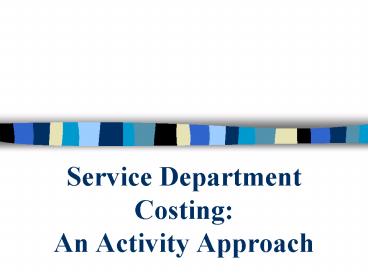Service Department Costing: An Activity Approach PowerPoint PPT Presentation
1 / 45
Title: Service Department Costing: An Activity Approach
1
Service Department CostingAn Activity Approach
2
The Need for Cost Allocations
OperatingDepartments
ServiceDepartments
Carry out the central purposesof an
organization
Provide supportthat facilitates theactivities
of operatingdepartments
3
The Need for Cost Allocations
4
The Need for Cost Allocations
Second, we measure theconsumption of
theallocation base in theoperating departments.
5
The Need for Cost Allocations
Third, we allocate the servicedepartment cost
based on the relative amount of theallocation
base used in eachoperating department.
6
The Need for Cost Allocations
What happens toservice departmentcosts after
they areallocated tooperatingdepartments?
7
The Need for Cost Allocations
I get it. They becomea part of the
overheadthat is applied toproducts with
apredeterminedoverhead rate.
8
The Need for Cost Allocations
First Stage Allocations Service department costs
are allocated to operating departments.
Service Department (Cafeteria)
Operating Department (Machining)
Service Department (Accounting)
The Products
Operating Department (Assembly)
Service Department (Personnel)
9
The Need for Cost Allocations
Second Stage Allocations Operating department
overhead costs and allocated service department
costs are applied to products.
Service Department (Cafeteria)
Operating Department (Machining)
Service Department (Accounting)
The Products
Operating Department (Assembly)
Service Department (Personnel)
10
Guidelines for Cost Allocation
- Allocation bases
- Interdepartmental services
- Allocating costs by behavior
- Allocation pitfalls to avoid
- Allocation of actual or budgeted costs
11
Selecting Allocation Bases
Personnel Number ofemployees
Custodial Squarefootage
Receiving Unitshandled
Cafeteria Number ofemployees
Easiest
Security Squarefootage
Power Kilowatthours
Accounting Staffhours
12
Selecting Allocation Bases
Personnel Number ofemployees
Custodial Squarefootage
Receiving Unitshandled
Cafeteria Number ofemployees
Availabilityof space orequipment
Security Squarefootage
Power Kilowatthours
Accounting Staffhours
13
Selecting Allocation Bases
Personnel Number ofemployees
Custodial Squarefootage
Benefits receivedby the operatingdepartment
Receiving Unitshandled
Cafeteria Number ofemployees
Security Squarefootage
Power Kilowatthours
Accounting Staffhours
14
Interdepartmental Services
Problem Allocating costs when service
departmentsprovide services to each other
Solutions Direct Method Step method Reciprocal
method
15
Direct Method
Service Department (Cafeteria)
Operating Department (Machining)
Cost of servicesbetween service departments
areignored and all costs areallocated
directlyto operatingdepartments.
Service Department (Custodial)
Operating Department (Assembly)
16
Direct Method Example
17
Direct Method Example
18
Direct Method Example
Allocation base Number of employees
19
Direct Method Example
Allocation base Number of employees
20
Direct Method Example
Allocation base Square feet occupied
21
Direct Method Example
50,000 25,000 50,000
90,000
60,000
Allocation base Square feet occupied
22
Step Method
Operating Department (Machining)
Service Department (Cafeteria)
Service departmentcosts are allocatedto other
service and operatingdepartments.
Service Department (Custodial)
Operating Department (Assembly)
23
Step Method
Operating Department (Machining)
Service Department (Cafeteria)
Once a servicedepartments costsare allocated,
other servicedepartment costsare not
allocatedback to it.
Service Department (Custodial)
Operating Department (Assembly)
24
Step Method
Service Department (Cafeteria)
Operating Department (Machining)
Custodial willhave a newtotal to allocateto
operatingdepartments itsown costs plusthose
costsallocated fromthe cafeteria.
Service Department (Custodial)
Operating Department (Assembly)
25
Step Method Example
We will use the same data used in the direct
method example.
26
Step Method Example
Allocate Cafeteria costs first sinceit provides
more service than Custodial.
27
Step Method Example
Allocation base Number of employees
28
Step Method Example
Allocation base Number of employees
29
Step Method Example
Allocation base Number of employees
30
Step Method Example
31
Step Method Example
Allocation base Square feet occupied
32
Step Method Example
50,000 25,000 50,000
150,000
100,000
Allocation base Square feet occupied
33
Reciprocal Method
Service Department (Cafeteria)
Operating Department (Machining)
Interdepartmentalservices are givenfull
recognitionrather than partialrecognition as
withthe step method.
Service Department (Custodial)
Operating Department (Assembly)
Because of its mathematical complexity, the
reciprocal method is rarely used.
34
Comparison of Methods
35
Allocating Costs by Behavior
36
Allocating Costs by Behavior
Budgeted costs should be allocatedto avoid
passing on inefficienciesfrom the service
departments.
37
Allocating Costs by Behavior
Allocations are made at the beginning of
theperiod to provide data for predetermined
overhead rates and flexible budgets. Allocations
are made at the end of the period to provide
data for comparing actualperformance to planned
performance.
38
Allocating Costs by BehaviorExample
SimCo has a maintenance department and two
operatingdepartments cutting and assembly.
Variable maintenancecosts are budgeted at 0.60
per machine hour. Fixedmaintenance costs are
budgeted at 200,000 per year.Data relating to
the current year are
Allocate maintenance costs to the two operating
departments.
39
Allocating Costs by BehaviorExample Beginning
of the Period
Hours planned
Percent of peak-period capacity.
40
Allocating Costs by BehaviorExample End of the
Period
Hours used
Percent of peak-period capacity.
41
Allocating Costs by BehaviorExample
Fixed cost allocations are the same because they
are based on capacity instead of usage.
42
Allocation Pitfalls to Avoid
Pitfall 1 Using salesdollars as anallocation
base
43
Allocation Pitfalls to Avoid
Pitfall 2 Allocating fixed costs using a
variableactivity allocationbase
44
Should All Costs Be Allocated?
45
Should All Costs Be Allocated?

